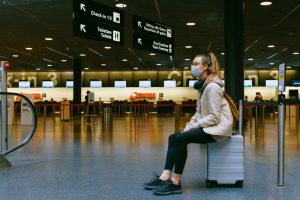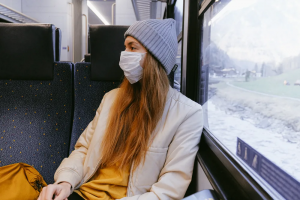 The dog days of summer have truly set in, and the COVID-19 pandemic isn’t slowing down. But does that mean you can’t travel? While traveling is certainly riskier than staying at home, it can be a moderate-risk proposition if you do it safely. Be diligent about hygiene and social distancing practices when traveling, and try to avoid places where groups of people gather — like airports, campgrounds, restaurants, and beaches. That may be harder while traveling, but it’s definitely doable with a little advance planning.
The dog days of summer have truly set in, and the COVID-19 pandemic isn’t slowing down. But does that mean you can’t travel? While traveling is certainly riskier than staying at home, it can be a moderate-risk proposition if you do it safely. Be diligent about hygiene and social distancing practices when traveling, and try to avoid places where groups of people gather — like airports, campgrounds, restaurants, and beaches. That may be harder while traveling, but it’s definitely doable with a little advance planning.
1) Travel by Car or RV If You Can
Using any form of public transport during the COVID-19 pandemic can put you at risk for contracting the disease — and that includes traveling by plane, train, or bus, where you’ll be in close quarters with other people. You should avoid bus and train travel if at all possible during the COVID-19 pandemic, and air travel is risky, too, but not for the reason you might think. The airplanes themselves have powerful air filtration systems, so as long as you’re not sitting within six feet of an infected, unmasked person, you’re less likely to catch COVID-19 from your fellow passengers on the plane. You’re actually more likely to catch it from coming into contact with other travelers at the airport. The safest way to travel during the COVID-19 pandemic is by car or RV, where you can have the most control over how many people you come into contact with. It should be safe to rent a car or RV — most rental companies are deep-cleaning vehicles between users to mitigate the spread of the virus. For extra safety, use hospital grade disinfectant wipes to clean frequently touched surfaces in the car, like the steering wheel, gearshift, radio control knobs, and so forth, each time you get in. Wipe down high-surfaces in your rented RV, too.
2) Pickup Food Curbside or From Drive-Throughs
Restaurants in many parts of the country are seating patrons again, but eating out is still a high-risk proposition because it requires being in an enclosed space and taking off your mask to eat. It’s safer to order food for curbside pick-up or grab food from a drive-through. If you’re traveling in an RV, it’s safe to buy groceries as long as you practice social distancing, wear a mask, and wash your hands thoroughly after putting everything away and before and after eating.
3) Wear a Mask in Public
Wearing a mask in public can help stop the spread of COVID-19. If you’re an asymptomatic carrier, or just haven’t started showing symptoms yet,  wearing a mask can protect others. It might offer you some level of protection against contracting the virus, and it can definitely protect others. You don’t have to wear your mask while riding in your car or RV, alone or with traveling companions, and you don’t have to wear it outside if you can stay six feet away from others. However, if you’re in a crowded area or go indoors, mask up for everyone’s safety. Bring plenty of 100 percent cotton, washable face masks on your journey, so you can change to a fresh one every eight hours, especially if you’re traveling a long way by plane. If you’re traveling by car, it’s okay to reuse the same mask throughout the day as you need to get in and out of your car, but grab a fresh one in the morning. If you’re staying in a hotel or RV, you can hand wash your face mask in hot soap and water to sanitize it, and hang it to dry. If there’s an iron available, ironing will provide further sterilization, but it’s not necessary.
wearing a mask can protect others. It might offer you some level of protection against contracting the virus, and it can definitely protect others. You don’t have to wear your mask while riding in your car or RV, alone or with traveling companions, and you don’t have to wear it outside if you can stay six feet away from others. However, if you’re in a crowded area or go indoors, mask up for everyone’s safety. Bring plenty of 100 percent cotton, washable face masks on your journey, so you can change to a fresh one every eight hours, especially if you’re traveling a long way by plane. If you’re traveling by car, it’s okay to reuse the same mask throughout the day as you need to get in and out of your car, but grab a fresh one in the morning. If you’re staying in a hotel or RV, you can hand wash your face mask in hot soap and water to sanitize it, and hang it to dry. If there’s an iron available, ironing will provide further sterilization, but it’s not necessary.
4) Clean Your Hands Often
COVID-19 can enter the body through the mouth, nose, and eyes, so it’s important to avoid touching your face unless you’ve just washed your hands. Wash your hands thoroughly, for at least 20 seconds:
- After you’ve been in a public place, and touched high-touch surfaces like doorknobs, gas pumps, shopping carts, or cash registers, that other people have touched;
- Before you touch your nose, eyes, or mouth;
- After coughing, sneezing, or blowing your nose;
- After touching an animal, cleaning up animal waste, or giving an animal food or treats;
- Before and after eating;
- Before and after preparing food;
- Before treating a wound, even a minor one;
- After going to the bathroom, changing a baby’s diaper, or helping a child use the bathroom; and
- After removing your mask but before touching your face.
Carry a small bottle of hand sanitizer with you to use if you can’t wash your hands. In many locations, such as at gas pumps, you may find gloves to use for additional protection while touching high-touch surfaces. It’s okay to use gloves, but you should still wash your hands or use hand sanitizer after taking them off and before touching your face.
5) Keep Your Distance
COVID-19 can travel quite far in the air — some scientists believe that it can travel as far as 30 feet on respiratory droplets, and , meaning it can travel on aerosolized respiratory particles smaller than 5 microns in size. To protect yourself, practice social distancing guidelines and stay at least six feet away from others. Avoid crowded beaches and parks, or wear masks while using them. Traveling is always risky, and with the COVID-19 pandemic still raging in the U.S., there’s a whole new level of risk to consider when you plan your next trip. Make taking precautions your top priority, so we can all get back to normal as soon as possible. 
